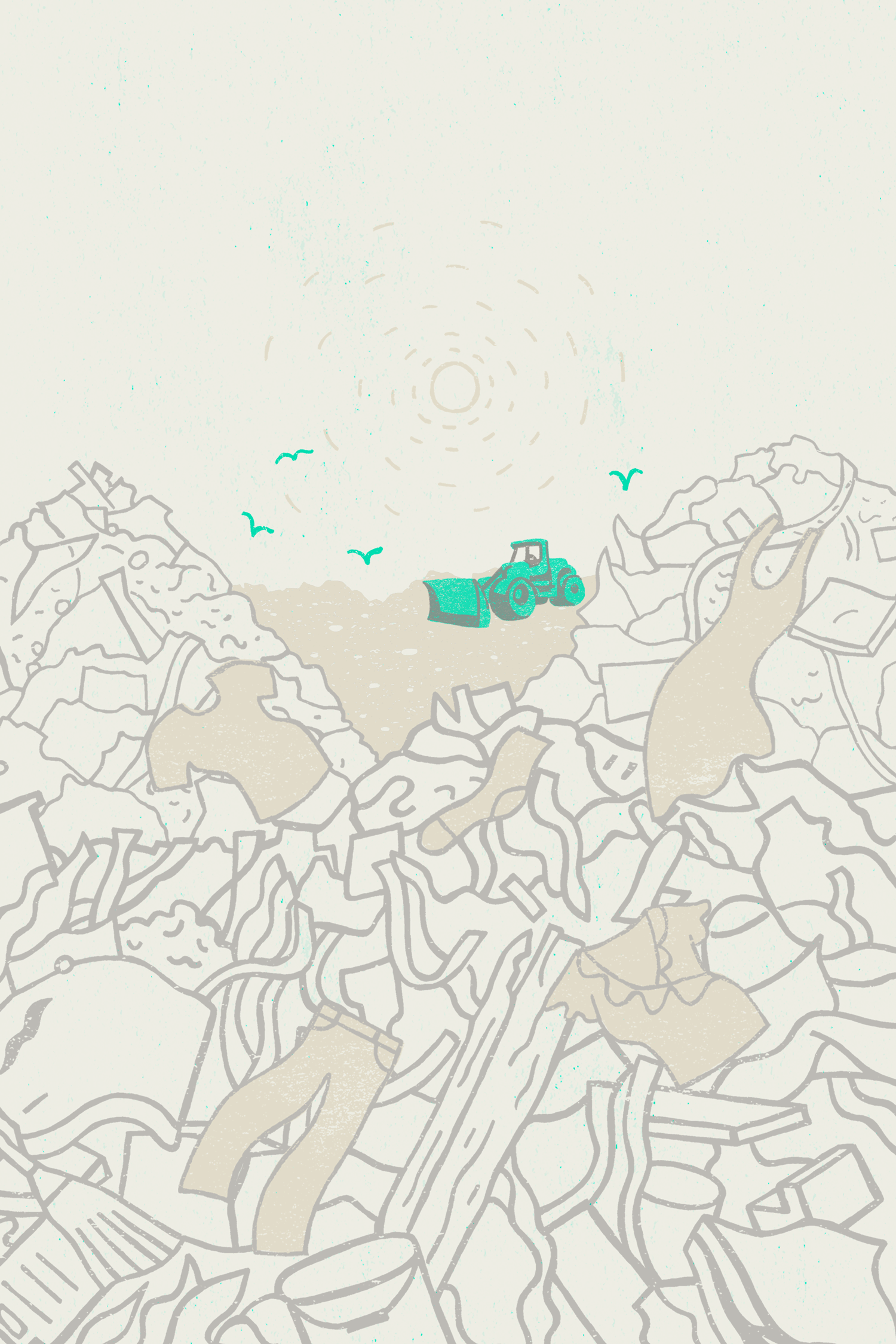This is the final part of our series exploring the ways policy change could facilitate progress for sustainability in fashion. We’re exploring the ways legislation could reform the management of raw materials, supply chain and end-of-life. Read part 1 and part 2 now.
The world has too many clothes. In the past year, people spent countless hours during lockdown cleaning out closets, while brands and retailers were left with collections they never had a chance to sell. The biggest problem with the clothing surplus: no one has a plan for what to do with it all.
“What we’re dealing with right now is a massive overload on our thrift stores, and our thrift stores are not waste managers. Our waste managers are trying to help — but that’s not how the infrastructure is built,” says Joanne Brasch, special projects manager for the California Product Stewardship Council, a nonprofit organisation focused on end-of-life programmes and policies in the US.
The surplus is a liability for fashion, according to experts, who say it adds pressure on the industry to act on climate change and other environmental crises. While some brands have launched take-back programmes in recent years in an effort to resell or recycle their used clothing, those address only small pieces of a larger puzzle. To adequately address what happens to clothing at the end of its life would require establishing the infrastructure for collecting clothes, developing the platforms for repairing and reselling them, scaling the technology for recycling them into new products and getting buy-in from both brands and consumers for every step of the process. That amounts to significant systemic change on both the global and local levels.
To get there, policies are needed that will drive the creation of collection and other infrastructure, while incentivising the overhaul of business models, say fashion companies, recyclers, waste processors and suppliers. Some policymakers around the world are starting to identify ways to hold the fashion industry to account for its impacts on the planet, including the waste its overproduction generates.
“Brands need to be held responsible for their own product lines’ circularity and the trash they produce,” says Joyce Hu, marketing director for Kenya apparel factory Wildlife Works. “End-of-life and circularity of both product and packaging must be baked into the initial product design. It’s hard to see this happening without policy in place to either incentivise, or tax and fine.”
Extended producer responsibility
The notion that brands should be responsible for what happens to their products when consumers are done with them is a concept known as extended producer responsibility, a goal that environmentalists have rallied behind for decades. Climate urgency is giving new life to EPR, particularly for fashion, one of the fastest-growing categories of trash that waste managers are confronting today.
EPR policies would charge a fee to brands when they put products on the market, holding brands responsible for waste management and ideally reducing production. According to the European Parliament, Europeans discard about 11kg of textiles per person every year, and 87 per cent of used clothing is incinerated or landfilled. Even for the minority of clothes that are donated, the best-case scenario for most is that they are worn by other users before eventually being discarded as well. As part of a larger goal to send no more than 10 per cent of all municipal waste to the landfill by 2035, textiles will need to be collected separately for reuse or recycling by 2025 across the EU, and individual countries are setting their own legislation.
An EPR policy in France charges brands a fee based on the number and weight of clothing items they put on the market, and the funds are used to collect and sort used clothing to keep them out of the landfill. “This law is meant to make the brands support the real cost of the end-of-life management,” says Maud Hardy, circular economy director at Refashion, the organisation responsible for implementing France’s extended producer responsibility programme, which was created in 2007. “It’s not a question anymore. You are a producer, you have to take charge of the cost of the management of the waste of what you produce.”
The UK is laying out an EPR mechanism in the current Environment Bill, which Rebecca Pow MP says will focus first on packaging but could eventually be used for textiles. “Lots of companies are realising they’ve got to have a more sustainable footprint. We’re trying to harness them, but if that doesn’t work, then we will introduce legal measures,” she says. That’s what happened with efforts on plastic bags, she says — it wasn’t until the 5p tax was imposed that it had a significant effect. “We will use them if we need to use them — and there’s a strong indication that we will.”
The Netherlands, which aims to be fully circular by 2030, is considering an EPR fee for clothing to accelerate textile recycling capacities. “That is our challenge. We want to become a frontrunner in Europe in using fibre-to-fibre recycling,” says Emile Bruls, advisor in the Dutch government’s circular department. The government has proposed targets for more recycled content in clothing and to keep at least 10 per cent of clothing designated for reuse within its borders, rather than exporting it, typically to Asia or Africa. Much will still be sent overseas, he says, “But we want to promote that people also in the Netherlands [should] wear more re-worn clothes.”
Leslie Harwell, partner at Alante Capital, says that the emergence of policies restricting where clothes can go can have ripple effects on the industry’s production model.
“Regulatory developments like this should be supportive of shifting dynamics around making overproduction increasingly less attractive, and encouraging brands to right-size production to demand,” she says.
Complex problems need complex solutions
Collecting textiles for recycling, and even banning them from landfills, are not themselves solutions for what to do with them instead.
In the US, while there’s no EPR effort at the federal level, the California Product Stewardship Council is pushing for legislation with state and local governments as an environmental strategy but an economic one as well. “We want a programme that prioritises reuse and regional job creation,” says Brasch. “We want more investment in the technology and jobs to manage these materials so we can get them into regional reuse.”
Efforts that tackle multiple problems at once, says Valérie Boiten, senior policy analyst at the Ellen MacArthur Foundation, help create a full policy ecosystem, rather than regulation in silos. “Policy should be mixed, tackling both upstream and downstream impacts,” she says.
The full-funnel approach to policy also helps to ensure more clothing is recyclable, as well as to avoid overreliance on recycling. A priority for Refashion in 2021, says Hardy, is to increase the proportion of clothing that gets reused. Experts say it’s paramount that reuse, and reducing waste in the first place, be the top priorities for end-of-life policies because they use far fewer resources than recycling.
“Recycling should be the last line of defense,” says Rachel Kibbe, founder of New York-based Circular Services Group. “We can get creative with what we incentivise in policy that makes recycling part of it rather than the focus.”
She expects to see a lot more brand-led resale and take-back programmes up and running by the end of the year, a sign that retailers won’t be caught off guard if and when they’re suddenly required to have a plan for managing the full lifecycle of their products. “I think brands know policy is coming and they are working hard to get their ducks in a row to be able to take responsibility both for their production and their end-of-life,” says Kibbe.
Globally, the biggest question is whether all the necessary stars will align — within and across markets, and in terms of environmental, social and economic priorities alike.
“The amount of infrastructure change and recycling capacity that we need to develop is so dramatic that we need these stepping stones,” says Cyndi Rhoades, founder of Worn Again Technologies. But ensuring those stepping stones are the right ones, and in the right order is a different story. “It is extremely delicate to get it right.”
To become a Vogue Business Member and receive the Sustainability Edit newsletter, click here.
Comments, questions or feedback? Email us at feedback@voguebusiness.com.
More from this author:
Redefining sustainability for 2021: The new priorities
The hidden obstacle to circular fashion: Chemicals
Bangladesh factories face smaller, less profitable orders this Christmas

